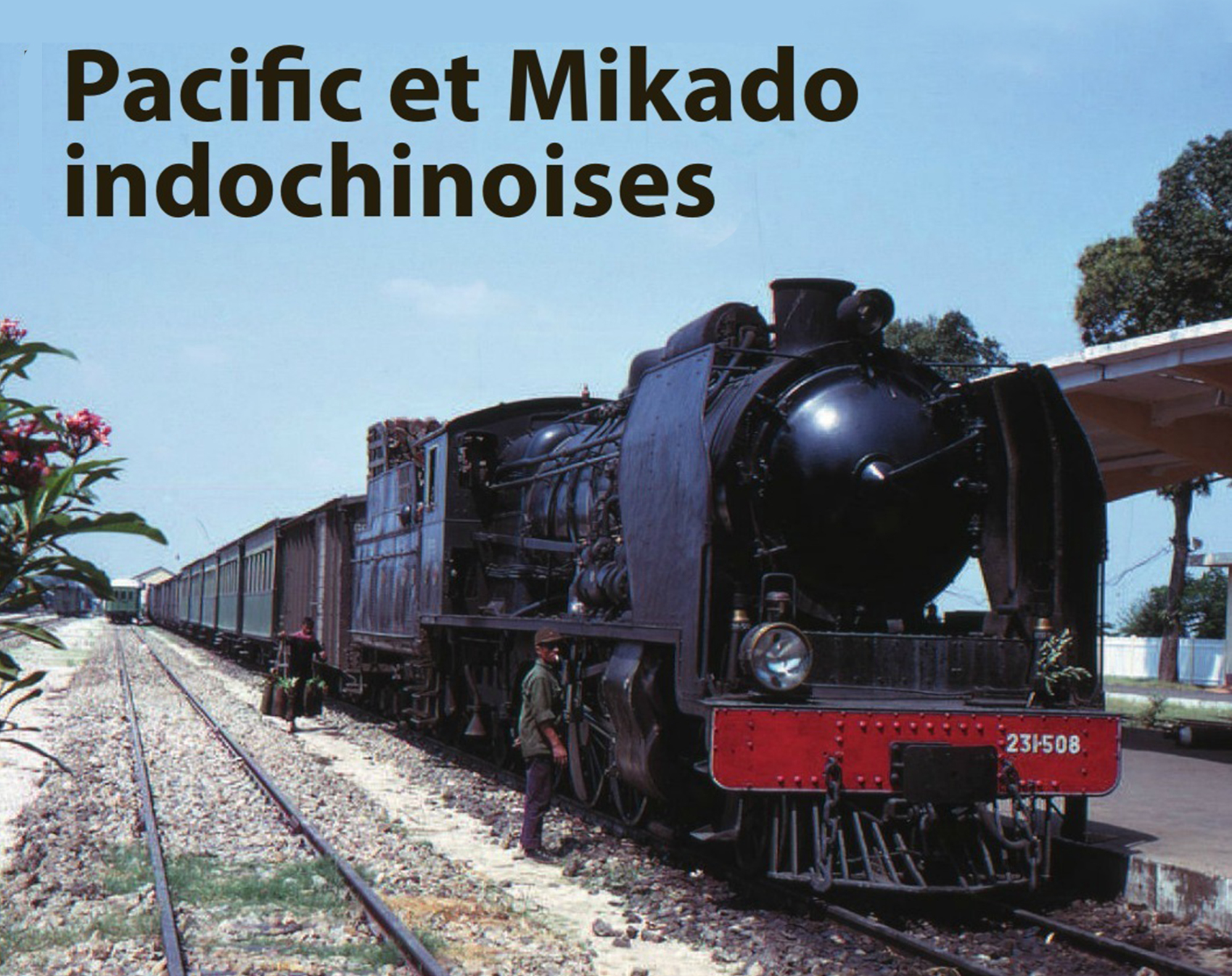
Translated from the article published in Chemins de fer régionaux et tramways (CFRT), September-October 2014
Our story begins in Indochina during the French colonial era, when 1m gauge routes stretched for over 3000km, from the north to the south of present-day Việt Nam and as far as Cambodia. Eighty years after their delivery to Indochina, and 60 years after independence, there are still some SACM “Pacific” and “Mikado” locomotives in existence, miraculously spared the decades of destruction.
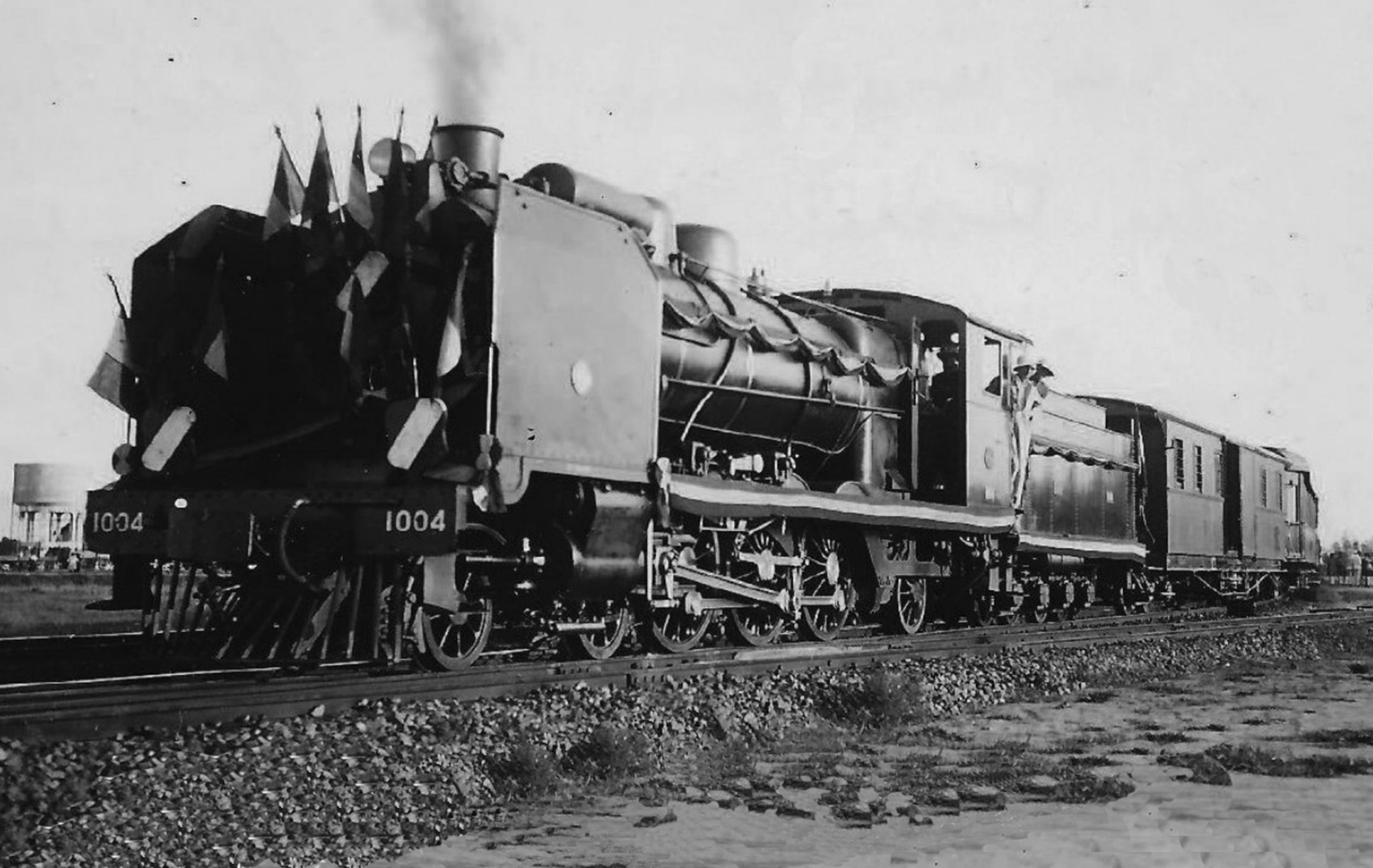
SACM “Pacific” No 1004, superbly decked out for the inauguration of the Transindochinois in October 1936. The first 10 locomotives of this series very quickly received smoke deflectors. Photo Sarthe/Collection José Banaudo
The administrative framework
In colonial times, the Federation of Indochina comprised Tonkin, Annam and Cochinchina, which today form Việt Nam, as well as Laos and Cambodia.
In Cambodia, the line envisaged at the outset as a route “from Phnom-Penh to Siam” – now Thailand – was granted in 1928 to the Compagnie des Chemins de Fer du Sud de l’Indochine (CFSI). It reached Mongkolborey in 1933, but the border crossing (PK 394) was not installed until 1942. In the meantime, in 1936, the failure of the concessionaire had led the Colony to entrust the line’s operation to the administration of Chemins de fer de l’Indochine (CFI). In 1952, the line was transferred to Chemins de Fer Royaux du Cambodge (CFRC), a creation of the “Associated State,” which then became the independent Royaume du Cambodge.
In Laos, the situation could not be simpler, since no public railway line project was ever to succeed in this country.
Within the perimeter of present-day Viet-Nam, on the other hand, the Doumer Plan of 1898 was to distinguish:
(i) A Hải Phòng-Hà Nội line of penetration extending north towards the Lào Cai border bridge to reach the Chinese city of Yunnan-fu (now Kunming) – this line was conceded to the Compagnie française des chemins de fer de l’Indochine et du Yunnan (CIY) and comprised 851km, of which 485km lay in Chinese territory;
(ii) A coastal axis called the Transindochinois, connecting Hanoi with Saigon and incorporating several branches – this network, not conceded to any private company, was built and operated by the colonial administration, then regulated by CFI, and comprised 2,192km.
While the Yunnan line was inaugurated in 1910, the Transindochinois would not be completed until 1936 (see CFRT No 368). After the fragmentation caused by the Japanese “coup” of March 1945, and then by the triggering of independentist actions, the southern sections (Saigon-Nha Trang and branches) and central sections (around Huế) of the line were reestablished and exploited by CFI, becoming the Régie des Chemins de fer du Viet-Nam in 1952, when, according to the terms of the Hả Long Bay Agreement, it was transferred to the “Associated State.”
In Tonkin, where only the CIY Hải Phòng-Hà Nội section and a very brief portion of the former CFI Transindochinois could be reopened, the technical and human resources of the two entities were united in 1947 in a Réseau provisoire ferroviaire commun CIY et RNC au Tonkin (CIY-RNC Provisional Common Rail Network, or RCT). The operation of the RCT was assured by both CFI and CIY, in both cases on behalf of the Colony and using its budgets. In this context, and of more particular interest here, the distinction between CFI and CIY locomotives was subsequently reduced to their registration; all the materials were then commanded and financed directly by the Ministry of Colonies, and it’s this situation which thus enables us to better understand the “expatriation” of the 231-A CIY Pacific locomotives, which were delivered to Saigon, rather than to Hà Nội.
After the 1954 independence agreements, political division intensified the physical divide between the Đường sắt Việt Nam (ĐSVN) networks north of the infamous 17th parallel and those of Việt Nam Hỏa Xa (VNHX) to the south. Regrouping, under the banner of ĐSVN, took place after Reunification in 1975.
[Note: There is no mention here of the more or less durable reopening, after 1945, of local lines in the Saigon region, on which only old and generally light locomotives were running]
Ten “Pacifics,” then 51 “Super-Pacifics”
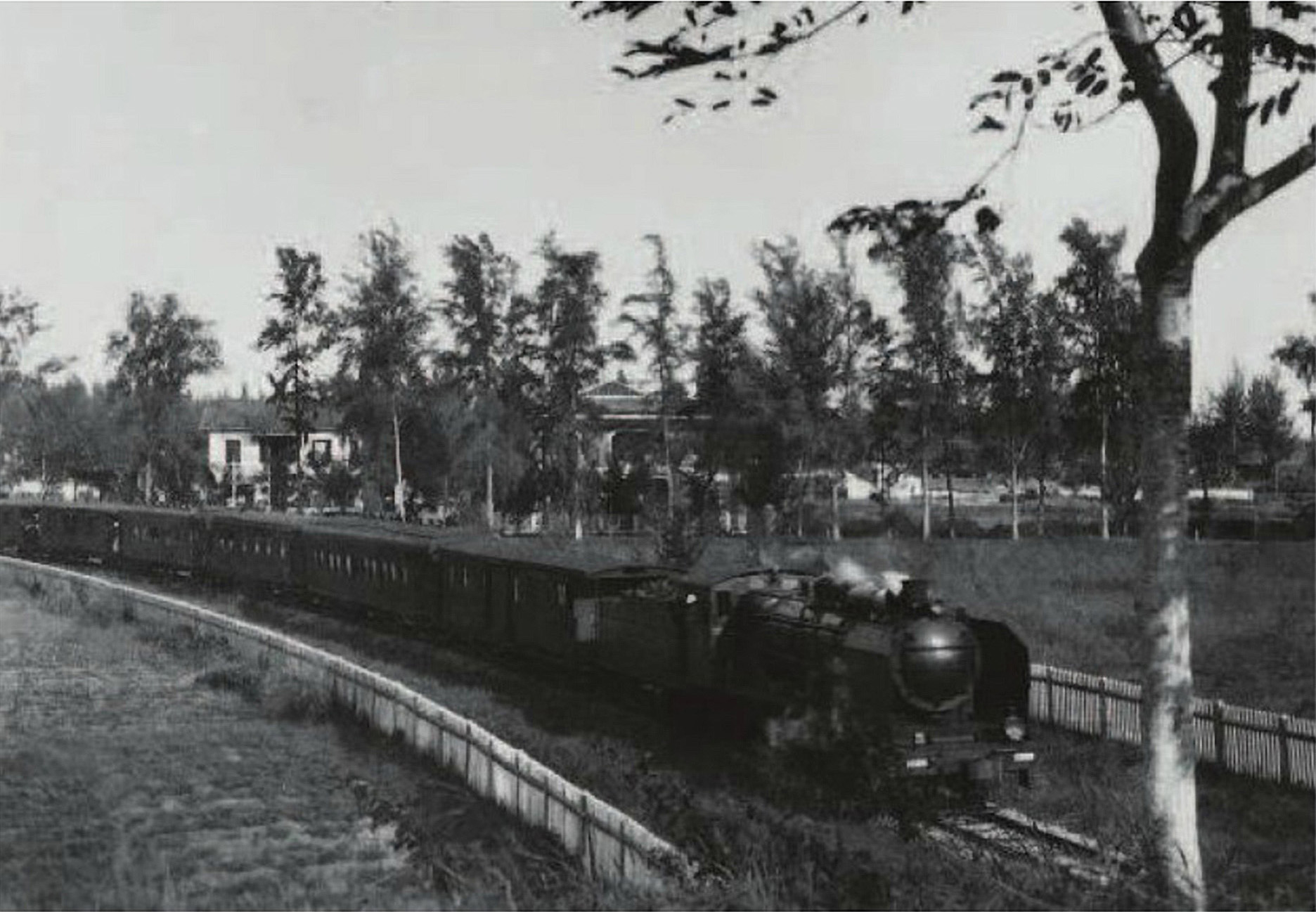
Tourane, 1936 – A “Pacific” of the first series, seen near Tourane at the head of the long Saigon express, shortly after the completion of the Transindochinois, Photo Sarthe, José Banaudo Collection
After its first successful application on the 1m gauge lines of the Tunisian protectorate, the “Pacific” type locomotive made its appearance in 1933 on Indochina Railways (CFI) as the long Hà Nội-Saigon artery (1730km) drew near to completion. The first delivery was of 10 type 188 locomotives of the Société Alsacienne de Constructions Mécaniques (SACM), numbered CFI 1000 to 1009, and subsequently, 231-301 to 231-310.
Immediately after the completion of the Transindochinois in September 1936, the increase in traffic justified new orders, this time for a significantly strengthened type, designated 194 by SACM, or “Super Pacific” by CFI¹. These locomotives, numbered 231-501 to 231-515, delivered in 1939, distinguished themselves from the outset by hauling long trains of metallic cars at 90 km/h. But the onset of war came to compromise and complicate everything – much more permanently here than anywhere else.
The first four units of the second tranche of “Super Pacifics” rolled out of the Graffenstaden factories from January 1940, and these locomotives, numbered 231-518 to 231-519. could be shipped without a hitch. Shortly after, Indochina was isolated by a maritime blockade. and 231-520, 231-523, 231-524 and 231-525 were reassigned to Dakar-Niger. By cross-checking between incomplete and sometimes contradictory documentary evidence, it can be argued that they would not reach their original destination until 1950². As for 231-521 and 231-522, still under construction at the time of the German invasion of Alsace, they were administratively concealed as “lots of spare parts” in order to escape requisition. In fact, the two locomotives were not completed and shipped until 1947 … and all these setbacks were further aggravated by the absence, for nearly a decade, of six Pacific tenders blocked in metropolitan France and then assigned to the Chemins de fer de Provence (see box below).
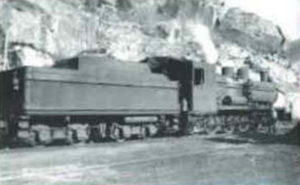
Dakar Corpet-Louvet 141 No 17 of Chemins de fer de Provence, seen at the Annot annex in the immediate aftermath of the war with its “Indochina” tender. The protective cover (a passive defence against aerial attacks) was always kept in place between the cab roof and tender. Photo Edmond Duclos, Collection GECP
“Indochine” Tenders in Provence
The passage of the colonies of French West Africa (AOF) to the camp of Free France in 1942 led the State Secretariat for the Navy and the Colonies to find a use in France for nine 141 type tenders which had been completed at the Corpet-Louvet factories in La Courneuve and destined for the Dakar-Niger Railway, but which had been separated from their locomotives. It was thus decided to assign them provisionally to the Chemins de fer de Provence, whose traffic could justify their use.
Six of them (40.017, 40.018, 40.020, 40.023 and 40.024) were delivered from May to July 1943 to the CP network of general interest of the Alps, in Draguignan. Three others (40.021, 40.022 and 40.030) were put into service from September 1943 on the local CP network of Littoral Varcis, in Saint-Raphael.
The construction of tenders having been subcontracted to another manufacturer, it was urgent to find replacements to couple to large Mikado locomotives. On the network of the Alps, makeshift tenders were fitted on flat wagon frames for the “Dakar” Nos 19 and 20, while No 23, sabotaged on its arrival, was never put into service and served as a spare parts reserve. There were therefore six machines left to be fitted with tenders: Nos 17, 18 and 24 of the network of the Alps, and Nos 21, 22 and 30 of the network of the Littoral.
At that time, six “Indochine” type tenders built by the Compagnie française de matériel de chemin de fer (CFMCF) at Tileul, near Maubeuge, were awaiting loading on the Marseille Arenc quay under the responsibility of the freight forwarder Daher. On examination of the available archives, it seems that they were intended for the Indochinese Pacifics, but could not reach their destination because of the hostilities. As the supplier had not been regulated, the credit insurance company which covered this transaction had become the owner and had relocated them to the Secretariat of State for the Navy and the Colonies, which had taken them into account as part of the AOF. The Ministry therefore undertook to resell them (at least those intended for the Alpine network, no archive relating to those from the Littoral having been found) to the two Provençal networks, with a buy-back clause for after the end of hostilities.
Between the Summer of 1943 and the beginning of 1944, the six tenders were sent to Draguignon and Saint-Raphael, where they were harnessed to the “Dakar” machines. Once the conflict was over, the locomotives were gradually withdrawn from service between 1945 and 1947. After retrocession to the State, still under the title of AOF railways, the six tenders were shipped to Corpet-Louvet by May 1948 to be renovated there before their final destination … which was therefore Indochina. According to Pascal Béjul’s research, they could have been harnessed to 231-521 and 231-522, which had remained blocked at the SACM factory during the war, to 231-520, 231-523, 231-524 and 231-525, sent temporarily to Dakar-Niger, or to 231-516, 231-517, 231-518 and 231-519, shipped to Indochina without their tenders.
José Banaudo
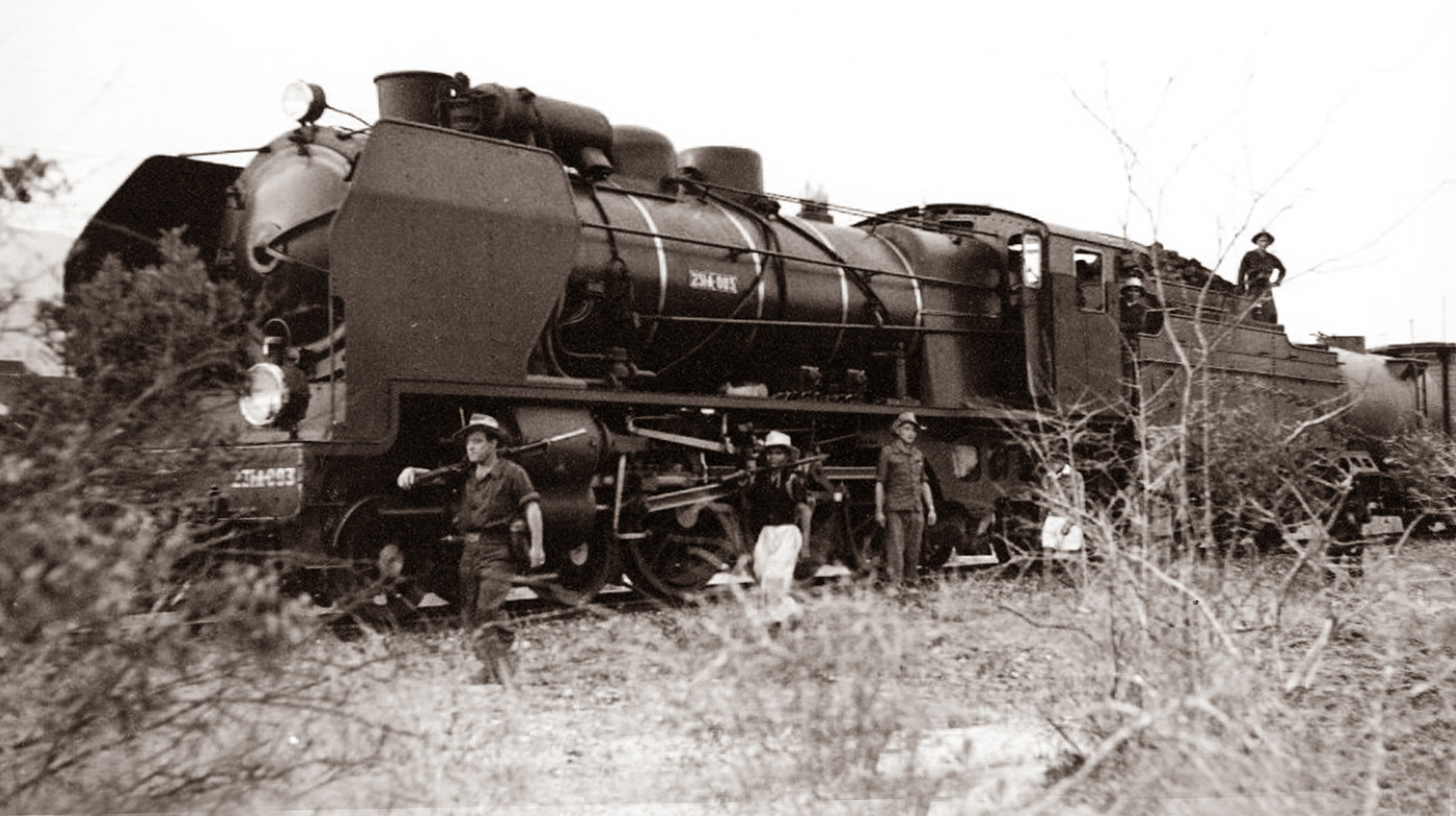
Việt Nam, 1947 – 231 “Pacific” No 231-003 hauls an armoured train en route from Saigon to Nha Trang, ECPAD Document
During the war years, the Indochina networks suffered very heavy losses and, in March 1946, an ambitious program of rehabilitation motivated new orders, not only for CFI, but also for the private company CIY. However, at that time, the Alsace factory was not in a position to respond to these requests, so these orders were lost to Haine-Saint-Pierre for 231-526 to 231-535 (for CFI), and to Fives-Lille for 231-A-001 to 231-A-006 (for CIY).
This was counting without the harassment of the Việt-Minh, who asserted themselves at the end of 1946 and opposed the resumption of the rail networks by the French: as a result of their actions, hundreds of kilometres of line could never be reopened, so that the needs were drastically reduced on what was recovered. Locomotives Nos 231-529 to 231-533 were “provisionally” allocated to Abidjan-Niger, while in France itself, in 1950, the embarkation of the 231-A locomotives was delayed for several months by the dockers of Dunkirk, who were opposed to the “colonial war.” To add to the confusion, the whole of this small series was assigned to the CFI Saigon-Nha Trang line, so that it was destined never to see “its” CIY Hải Phòng-Hà Nội line.
Even if the renunciation hour had not yet struck, the minimum operation maintained on an amputated and fragmented network could no doubt be served adequately with the existing fleet of locomotives … but despite this, a further, last tranche of 10 units (231-536 to 231-545) was still constructed by SACM in 1947-1948.

A side view of 231-507 – according the Cambodian numbering scheme and after adaption to wood burning. Photo Guy Rannou, Collection Yves Broncard
In Cambodia, a renumbering muddies the waters
Originally, the fleet of locomotives for the independent line of Cambodia had been entirely supplied by the German company Hanomag. Among these machines, two ex-CFSI “Pacific” locomotives were very quickly transferred to Saigon³. This transfer was compensated for by lighter CFI equipment (in particular: 230-300 Cail, then 131-100 Franco-Belge). Other exchanges followed, quite numerous despite the technical heaviness of transport by barge along the Mekong.
On 1 January 1951, five “Super Pacific” locomotives were in the Phnom Penh fleet. In the following year, during the transfer to the CFRC, these were included in a total of 10 locomotives of this type, which were soon renumbered as 231-500 to 231-510, a renumbering undertaken locally for the whole fleet – which means, confusingly, that that the current Cambodian 231-501 is not the 231-501 CFI locomotive of 1939!
The documents which have come down to us unfortunately do not allow us to determine the original “identities” of these renumbered Cambodian machines, with the two exceptions of 231-505 and 231-509 CFRC, which, in 1988, bore construction plates corresponding respectively to those of the former 231-538 and 231-542 CFI. We can therefore only suppose that the 1952 renumbering aimed to give an appearance of homogeneity to a stock which perhaps mixed ex CFI 231-500 locos together with ex-CIY 231-A locos, and we can also argue that this core of 10 ” Super Pacifics” was then to remain unchanging, because, after decolonisation, the relations between the two states of Việt Nam and the Kingdom of Cambodia would be sufficiently distant (a euphemism!) for any further exchanges to appear highly improbable.

“Super Pacifics” flourishing in Phnom Penh at the end of the 1950s: 231-500 ready for departure; 231-507 and 231-502 in the fuel parc, with bulky stacks of wood; 231-508 has just entered the station; as has 231-507, viewed from the upper floors of the main building of the station. Photos Guy Rannou, Yves Broncard Collection
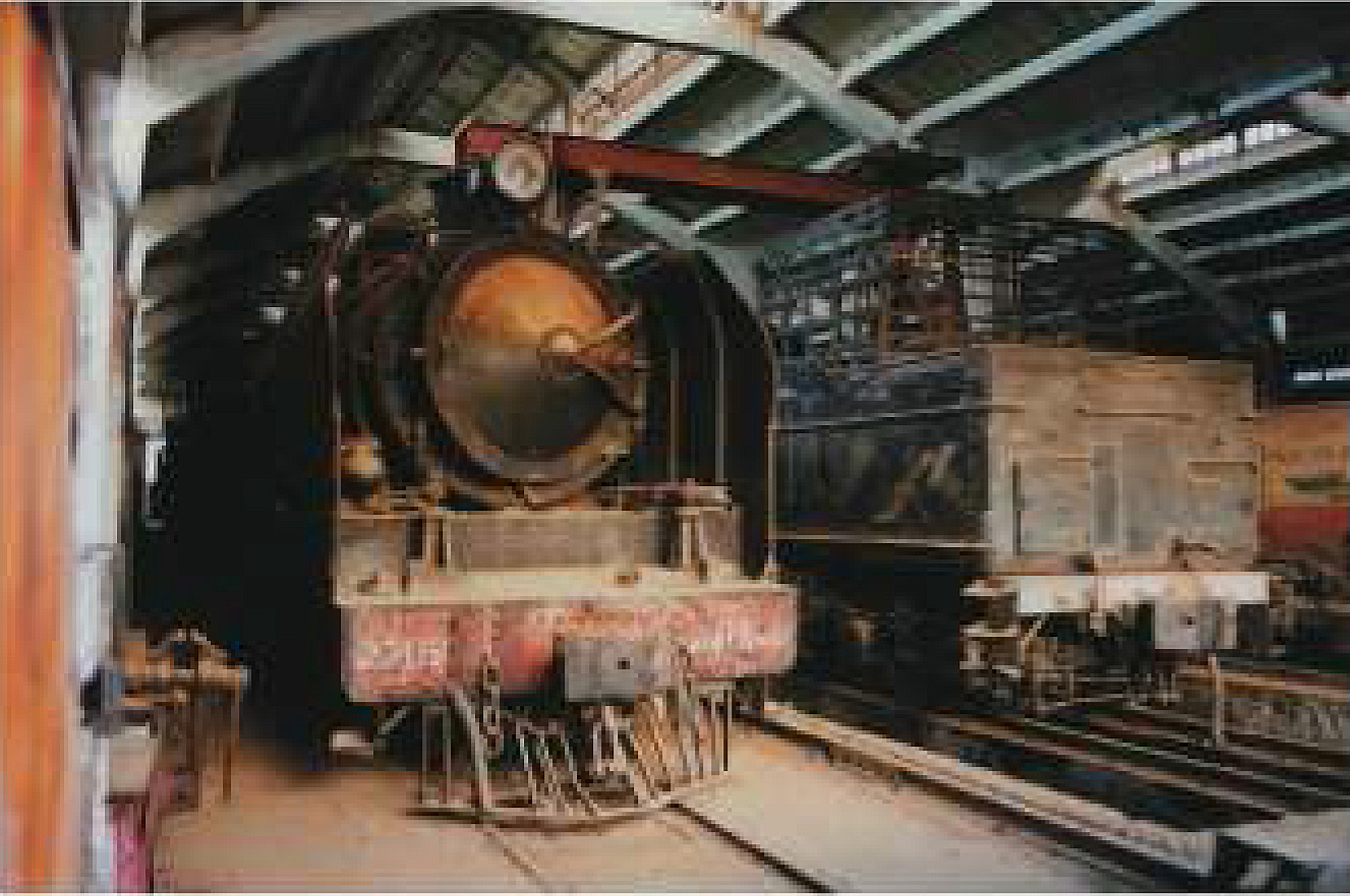
Three decades later, 231-508, originally CFI 231-542, was in store at Phnom Penh… it is still there in 2014. Photo Paul Carenco
The “Mikados” and their descendants
In mid-1946, SACM put into construction the first “Mikado,” its type 203, which differed from its predecessors only by the configuration of its axles, better adapted to the heavy and slow trains of a network ravaged by war. But the persistence of unrest in Indochina would profoundly affect the history of these locomotives, which was even more confused, if not painful to write about, than that of the “Super Pacifics.” For the orders initially planned, we note a distribution of attributions between CFI (141-501 to 141-528) and CIY (141-A-101 to 141-A-115)… of which the last deliveries would, however, only be partially implemented, when the prospect of a “liquidation” of the networks was no longer in doubt.
Locomotives 141-501 to 141-516 CFI began leaving the factory in 1948 … but, as with the contemporary “Super Pacifics,” their deliveries were disrupted due to the “general situation” in Indochina. Five locomotives of this batch (141-508 to 141-512) had to be “loaned” to Congo-Océan, after provisional conversion to 1.067m gauge. This loan, attested to by several documents, but about which we lack precise details, was extremely brief and ended at the start of the 1950s. In addition, eight other locomotives, inventoried by SACM as type 203-bis, were built specifically for the French Equatorial Africa network⁴.
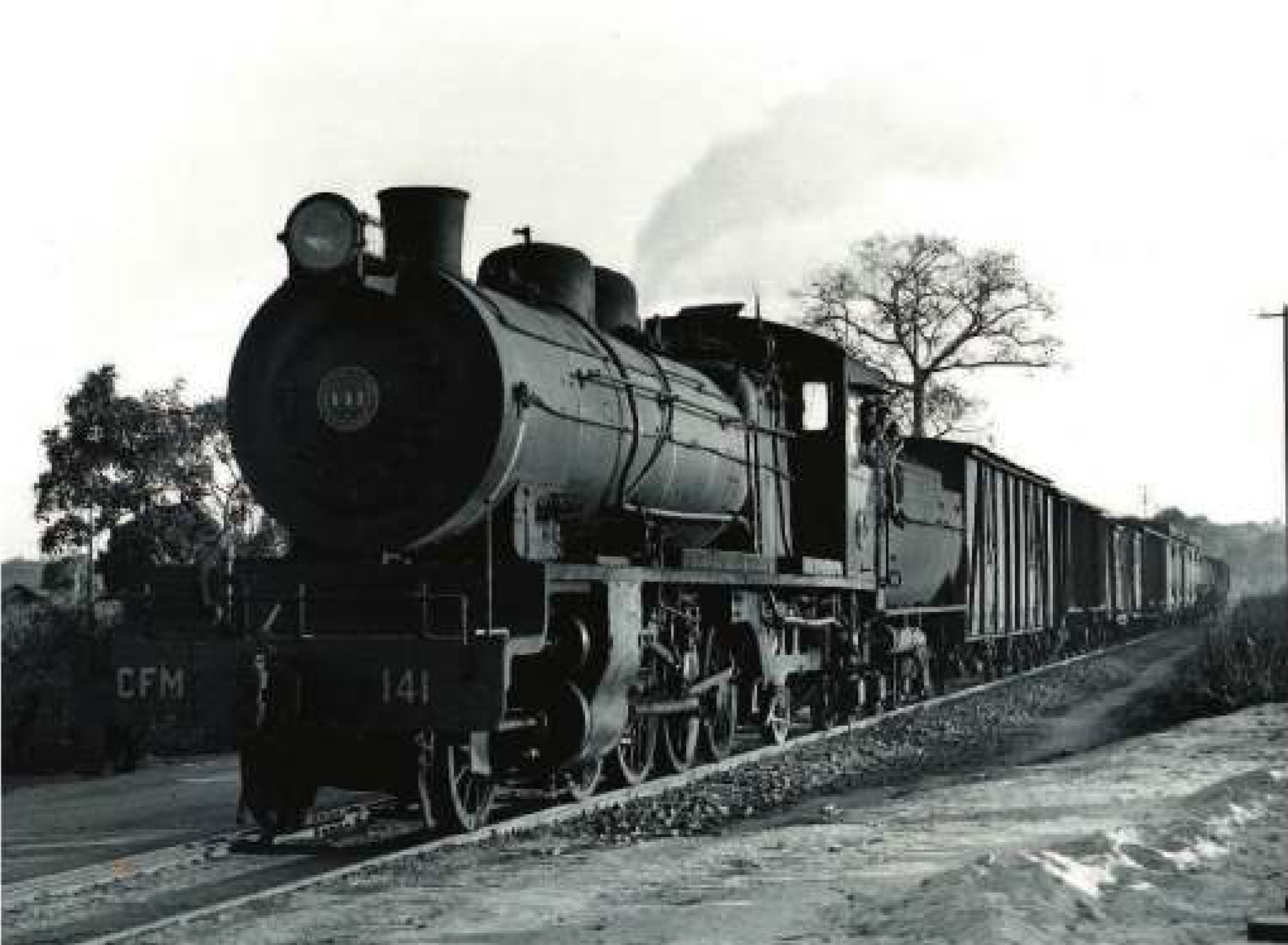
Close-up of 141 No 141 (!) of the Mozambique Railways, ex-50301 Congo-Océan. Deprived of its smoke deflector screens and carrying an American-style headlight and faceplate, the locomotive is almost unrecognisable … but it is nevertheless a sister of the Indochina “Mikado”, with its tank tender. The lighting emphasises in particular the rear side beams, which allowed the widening of the firebox. Photo AE Durrant/DR
In any case, in its inventory of 1 January 1951, CFI identified twelve 141-500 locomotives, distributed as follows:
– six in service of their southern network,
– three in service of their central network,
– three “in the course of assembly,” meaning that shipping had been carried out in disassembled elements (chassis, boiler, superstructures).
Units 141-517 to 141-528, ordered in 1947, were delivered in 1950 and 1951. Curiously, neither the manufacturer’s documents, nor those of the Office Central des Chemins de fer d’Outre-mer (OFFERFROM)⁵, seem to “know” the last unit, whose existence is only attested by a photo of it taken after an attack. Moreover, in the Autumn of 1949, CFI had sought to cede, to third-party networks, 16 of their “Mikado” locomotives which were still under construction, and which, in an increasingly difficult context, they no longer required. But no-one was interested in taking these locomotives, and while awaiting a decision, OFFERFROM was forced to take delivery, having them stored for many months in a warehouse located in Albert (Somme), together with a great deal of other rolling stock which had also been ordered for Indochina.

Tourane, 1951 – SACM Mikado No 141-525 was initially sent to Congo before its eventual delivery to Indochina
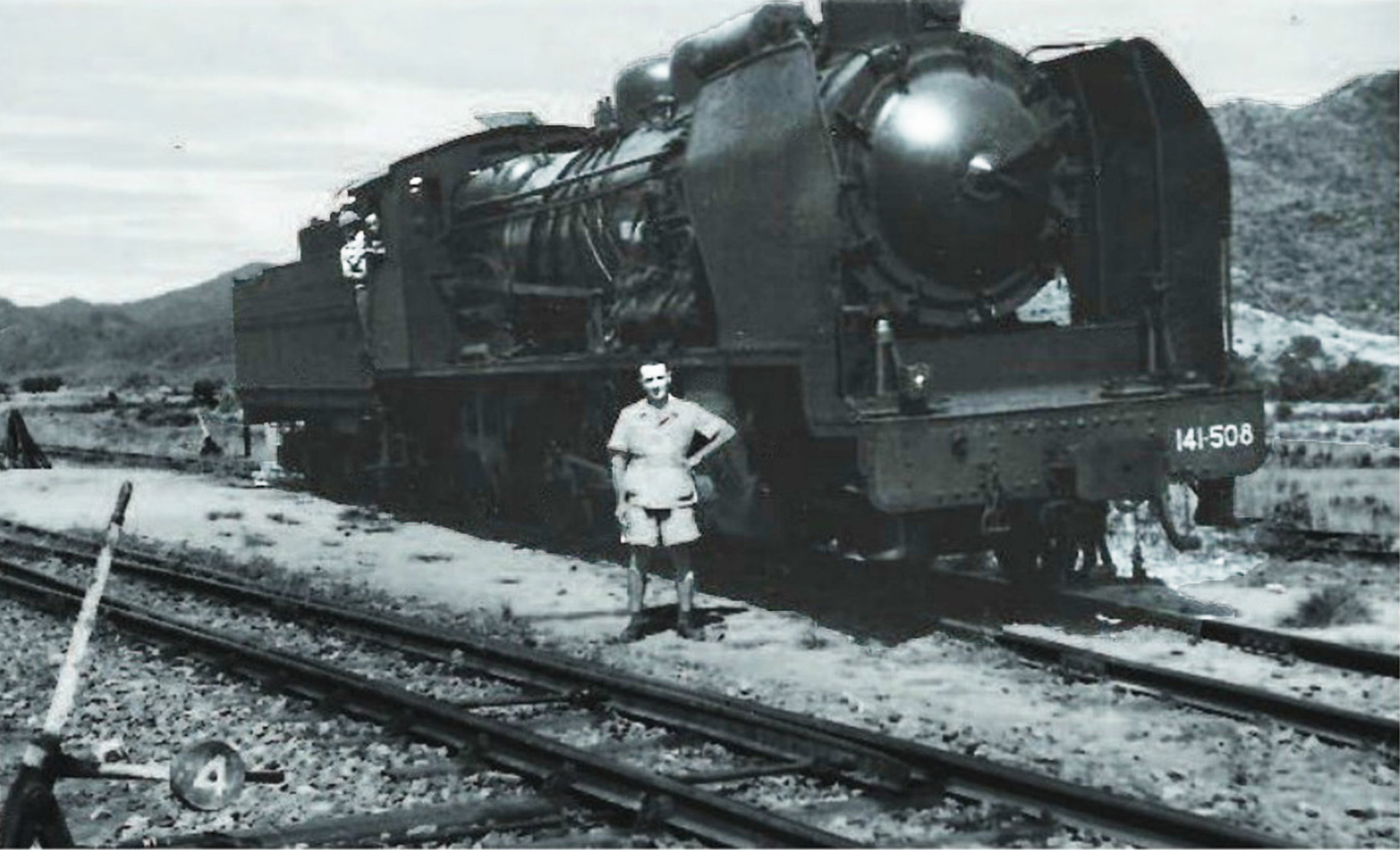
Tourane, 1951 – SACM Mikado No 141-508 was initially sent to Congo before its eventual delivery to Indochina; it’s seen here at Liên Chiểu
In addition to these measures, taken “for budgetary reasons” though no doubt concealing the loss of all hope of new redeployments, the government added the cancellation of a new order for 15 “Mikados” which had only been placed a few months earlier.
The same causes would produce the same effects in relation to the 141-A locomotives destined for CIY, whose order was reduced from 16 to 10 units in May 1949, then reduced again to only eight units in the following year. These locomotives, 141-A-101 to 141-A-108, were put into service in 1951 and 1952 on the Hải Phòng-Hà Nội line, the last operational line of the CIY concession.
After the 1954 independence agreements, North Việt Nam seems to have inherited about ten “Mikados” including at least seven of the eight 141-A ex-CIY locomotives, and South Việt Nam more than 20, all of them of CFI origin. Moreover, it is now established that 141-515 found refuge in Phnom Penh, where it was renumbered as 141-551 CFRC⁶.

No 141-165, of Chinese manufacture, seen hauling a freight train in Hà Nội in 2001, shortly before steam haulage was brought to a definitive end in Việt Nam. Photo Paul Carenco
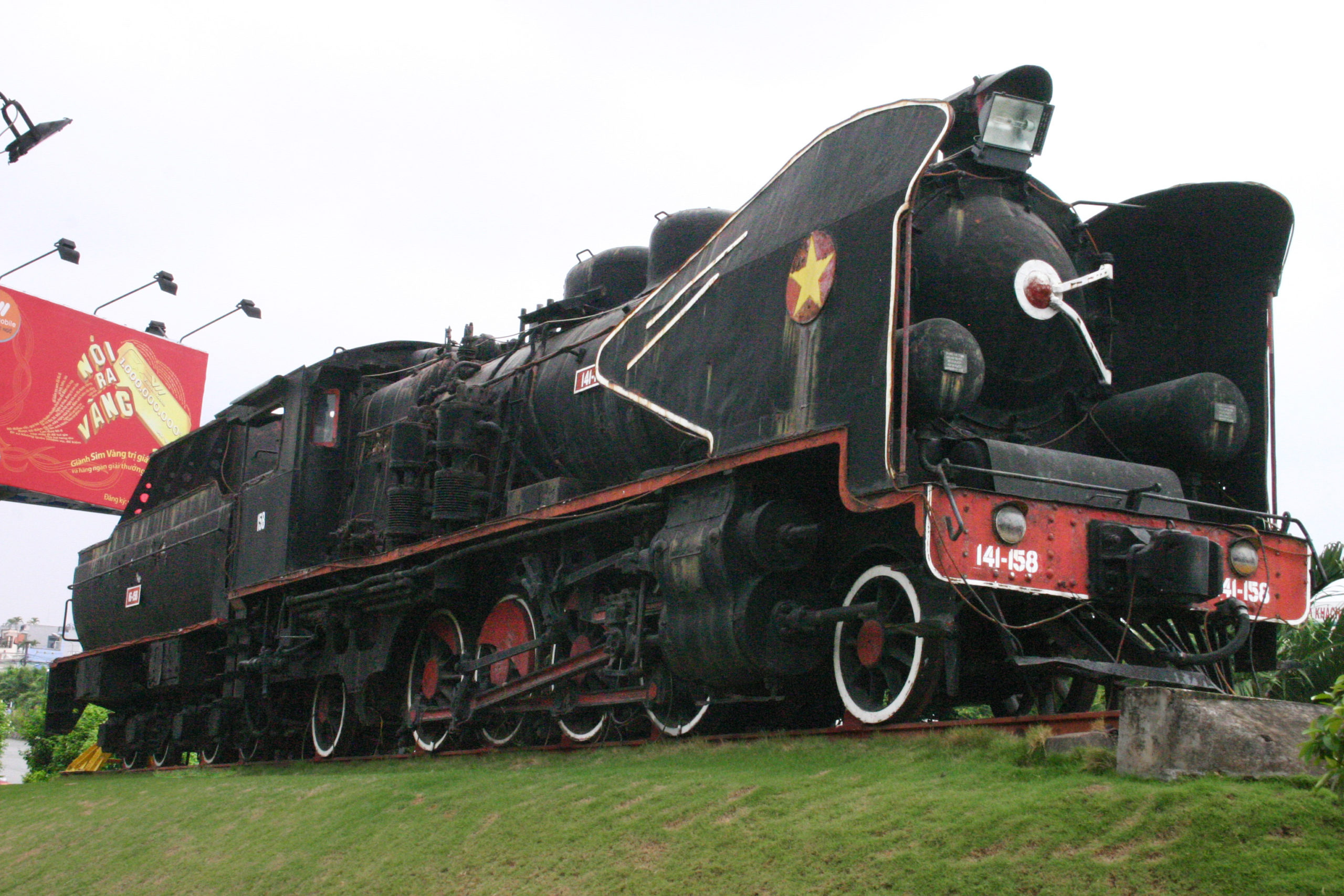
No 141-158, also a Chinese built copy of the SACM Mikado, which has been set up as a monument in front of the Hồ Chí Minh City Station, photographed in December 2013. Photo Michel Garel, Source: Piotti
In South Việt Nam, the American takeover, materialised by the contribution of about 50 diesels from the General Electric construction line, marked the death warrant for steam locomotives – most of them were left abandoned by the end of the 1960s. It was quite different in the North, where the Communist regime remained faithful to the machines inherited from the former colonising power. The 141-A ex-CIY locomotives lost their “A,” and the 141-500 ex-CFI locomotives taken over by ĐSVN were renumbered in sequence after them, from 141-109 onwards; after Reunification, some 141-500 locomotives from the centre and/or the south were transferred to the north, where ĐSVN rehabilitated and renumbered them, to at least 141-115⁷.
And they did not stop there: in 1964, the workshops of Gia-Lâm built locomotives Nos 141-121 and 122, replicas of the SACM “Mikados,” which resulted from a subtle mixture of “cannibalisation” of the cancelled machines, use of spare parts, identical machining and, of course, ingenuity. When the liaison between Hà Nội and Saigon was re-established, it was undoubtedly on purpose that No 141-121, which had become an object of national pride, was placed at the head of the inaugural Unification Express, at least for its arrival in Hà Nội on 4 January 1977.
In addition, these two locomotives were followed by Nos 141-151 to 141-216, built by Chinese industry between 1965 and 1974, making in total no less than 67 “copies.” So the plans of SACM had not been “lost to all the world!”⁸
As late as 1992, it was still possible to see SACM “Mikados” hauling expresses from Saigon between Hà Nội and Nam Định (87km). They were then among the very last French steam locomotives in regular service anywhere in the world. After the complete dieselisation of the network in 2002, it seemed that all the steam locomotives had gone, but their Chinese-built “sister,” 141-158, was installed as a monument in front of the new station in Hồ Chí Minh City, ex-Saigon. Faced with this escapee, how can we not recall a very old rule: over time, the success of a plagiarism always ends up constituting the most beautiful tribute that we can pay to the authors of the original!
Forgotten … and nevertheless legendary
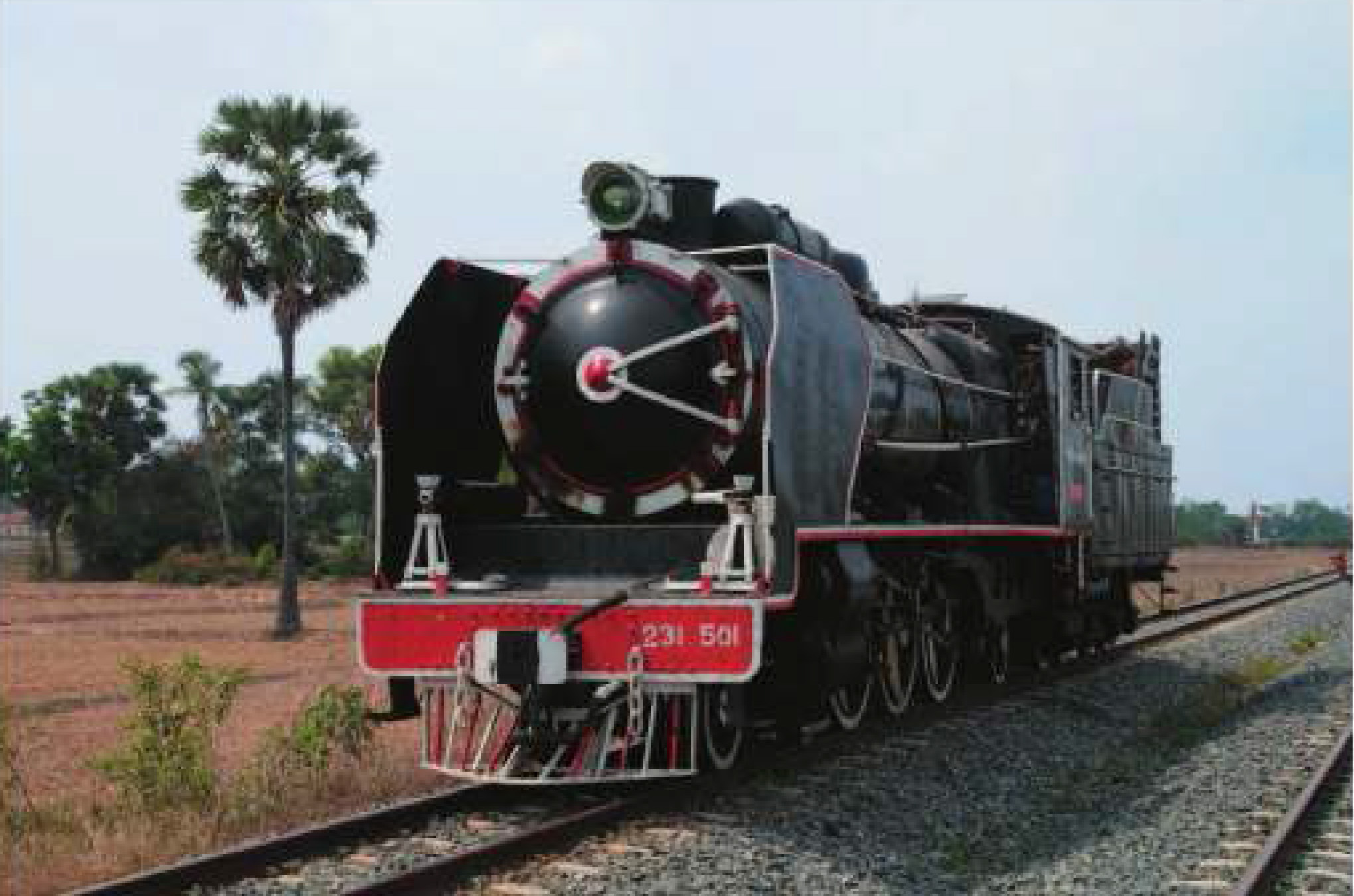
Restored Cambodian No 231-501, last survivor of the “dynasty,” pictured on 26 March 2014 running around its train at Komar Reachea, PK47, on the Phnom Penh-Sihanoukville line
In essence, and without taking into account the “copies” of Vietnamese or Chinese execution:
– 61 “Pacifics” and “Super Pacifics” were built for CFI and CIY.
– 36 “Mikados” were built for the two networks, and this type of locomotive was reproduced in a total of 44 examples, including the Congo-Océan lot.
With a total of 105 units, these locomotives have formed a truly exceptional “large family” in the history of French 1m gauge steam traction, even unique if one considers only the decades 1930 to 1950. In addition, through many of their technical features, the Indochina 141 and 231 locomotives presaged the famous 142 and 242 GELSA locomotives of 1951-1953, also of 1m gauge, which were to constitute the definitive design of the French “school” of steam locomotive.
And yet … due to their remoteness, but also perhaps due to the discredit thrown on the 1m gauge track by some and on colonisation by others, the “Pacific” and” Mikado” locomotives of what was French Indochina have never known the notoriety of their counterparts which worked the large metropolitan networks, except of course with those who experienced the epic adventures of the armoured trains and “Rafales,” already more than 60 years ago.
The independentist attacks of the years 1946 to 1954, although innumerable, did not bring about the complete disappearance of all locomotives; most often, the damage could be repaired in the workshops, where every unit of the fleet would experience several successive stays. After 1964, the bombings of the “American War” were more destructive, but several “Pacific” and “Mikado” locomotives survived them all the same, to accomplish their tasks until very recent dates.
In Tonkin, at the end of the 1980s, nine “Pacifics” and “Super Pacifics” (231-302, 231-309, 231-524, 231-525, 231-527, 231-528 to 231-530 and 231-533) could be found parked out of service, but 231-534 was still in operation in Hà Nội, while seven “Mikados” out of a total of nine (141-102, 141-103, 141-105 to 141-110 and 141-115 according to the numbering of ĐSVN) could be found hauling trains to Nam Định, Lạng Sơn and Hải Phòng.
At the same time, in the former South Việt Nam, entirely converted to diesel, Nos 141-507 and 141-510 had just been scrapped, and only the wrecks of the 231-A-003 and 231-A-006 of CIY origin could still be seen dumped in Nha Trang.
In Cambodia, after minimal dieselisation, almost all of the fleet survived the destructive madness of the Khmer Rouge to reach us today. In Phnom Penh, we know that the 231-501 – according to the local numbering here – has just been restored to life; 231-502 to 231-505, as well as 231-508 and 231-509, are stored and seem almost complete, along with 141-551, ex-141-515, last of the SACM “Mikados;” 231-506 and 231-507 are badly degraded; and only 231-510 seems to have disappeared.
Is it necessary to add: Can the hopes of preservation and transfer to France of one of these locomotives, which in 1992 were concentrated on 231-534 in Hà Nội, be considered today as definitively dashed?
Another regret: since the publication of Frédéric Hulot’s book, a quarter of a century ago (see bibliography) some persistent enigmas have certainly been elucidated … but there are still many unanswered questions! Thus, it is feared that the details of the origins of most of Cambodia’s miraculous survivors, as well as the service records of expatriate locomotives in Africa, will remain forever unknown.
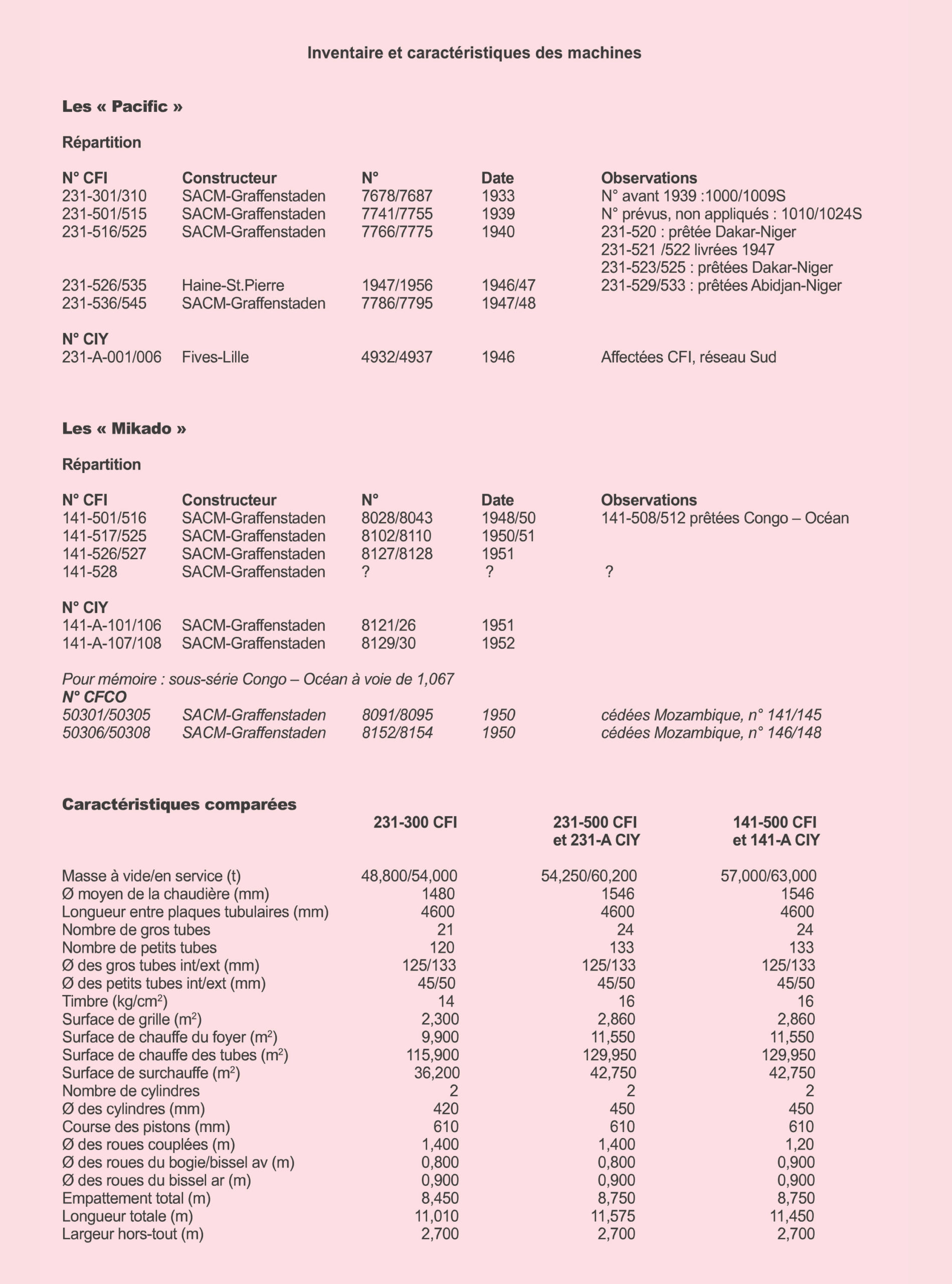
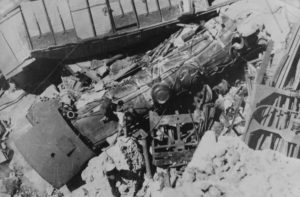
On 22 June 1953, a Việt Minh attack on the railway in the Hải Vân Pass precipitated Việt Nam’s worst-recorded railway disaster. A strong explosive charge was detonated just as a 15-coach passenger train double-headed by two brand-new “Mikado” 141-500 locomotives arrived at the Baika viaduct (km 761). The viaduct collapsed and the entire train plunged into a ravine, killing more than 100 passengers and crew. Photo Sarthe, Collection Jose Banaudo
Three steam locomotives, or nothing!
Around 1959, when all the colonial networks were engaged in a forced dieselisation, Indochina Railways swore by their “Super Pacifics” and “Mikados.” This position, against the tide of opinion, was justified by the qualities of these locomotives, and it was also explained by Indochina’s abundance of water resources and, in the north, by the relative proximity of the Tonkin coal mines … but that was not the only reason.
Lúc Raynaud reports that an administrator of OFFERFROM, after having masterfully demonstrated to his audience how “a single diesel locomotive replaces three steam locomotives,” heard himself answered by a leader of the CFI: “Well as for me, I keep my three steamers. because, when the Việt-Minh sends one to the bottom of a ravine, I still have two left to pull my trains.” Unstoppable!
It was this mixture of common sense and determination, reinforced by the incredible ingenuity of Vietnamese and Cambodian railway workers, which explains why some of these beautiful locomotives were able to survive through those tragic decades ….
The “Pacifics” of 1933
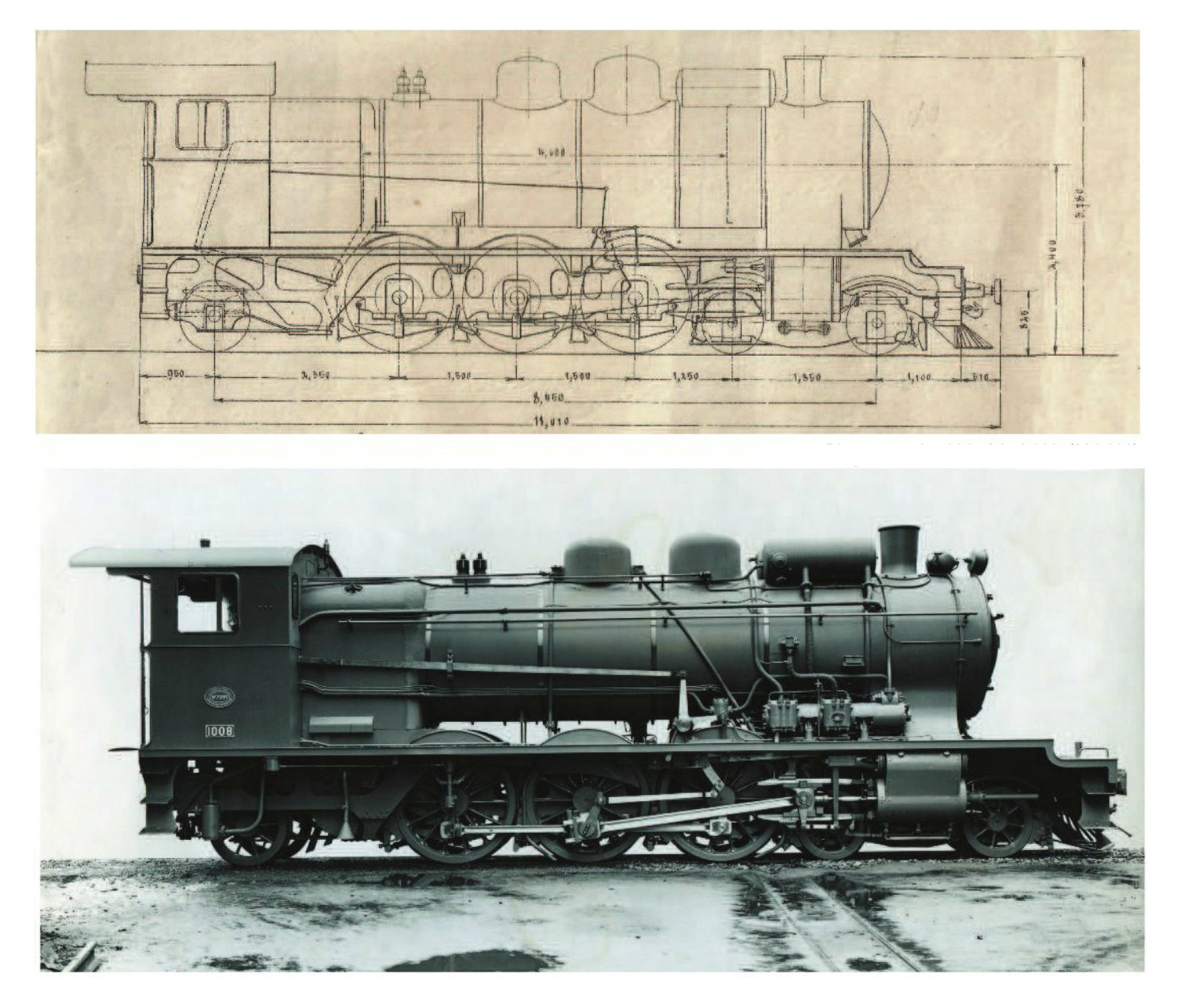
Schematic diagram and ex-works photo of SACM-Graffenstaden 2-8-2 “Pacific” No 1008, future 231-309 (SACM No 7688, 1933), Collection André Lepage
The 1933 series, later 231-300, was presented by SACM as a reduced version of the “Pacific” that it had built in 1914 and then in 1928 for the Tunisian metropolitan areas. In fact, the lighter rail of the first-completed sections of the Transindochinois limited the axle load to 11 tonnes. The manufacturer succeeded in reducing the empty weight from 51.9 to 48.8 tonnes, while increasing the power of the locomotive, thanks partly to the enlarged grate and heating areas and the increase in stamp boiler pressure from 12 to 14 hpz, but also through the application of some of the principles of André Chapelon: thus did they conduct “an in-depth study of the exhaust steam and smokebox gas ratios” and adopt the Kylchap exhaust.
The main deviation from the designs of that illustrious engineer, a simple expansion, was justified by the narrowness of the space between the side beams, which hardly permitted the accommodation of an interior mechanism, and undoubtedly even more by the imperative of facilitating both driving and maintenance.
It was specified that the length of the grate should not exceed 2.50m, “in order to facilitate correct heating by colonial staff.” The manufacturer also reproduced the provisions which characterised the Tunisian type, with a “special type of frame which accommodated a wide and deep firebox between the side beams” – the main side beams stopped at the front of the firebox, while the rear ones were extended to embrace the firebox, beyond the third coupled axle, so as to achieve a rigid assembly.
The diameter of the coupled wheels, fixed at 1.50m on the Tunisian “Pacifics,” was reduced to 1.40m on their Indochinese descendants, an arrangement which a metropolitan operator would not have classified in the prestigious category of “big wheels.”
The other characteristics were classic ones: thus, the mechanism included numerous parts which were interchangeable with previous types of locomotives – 230 Cail and Fives-Lille in particular – to take into account delays in workshop supplies, and several weeks of navigation from the metropolis.
The “Super Pacifics” of 1939
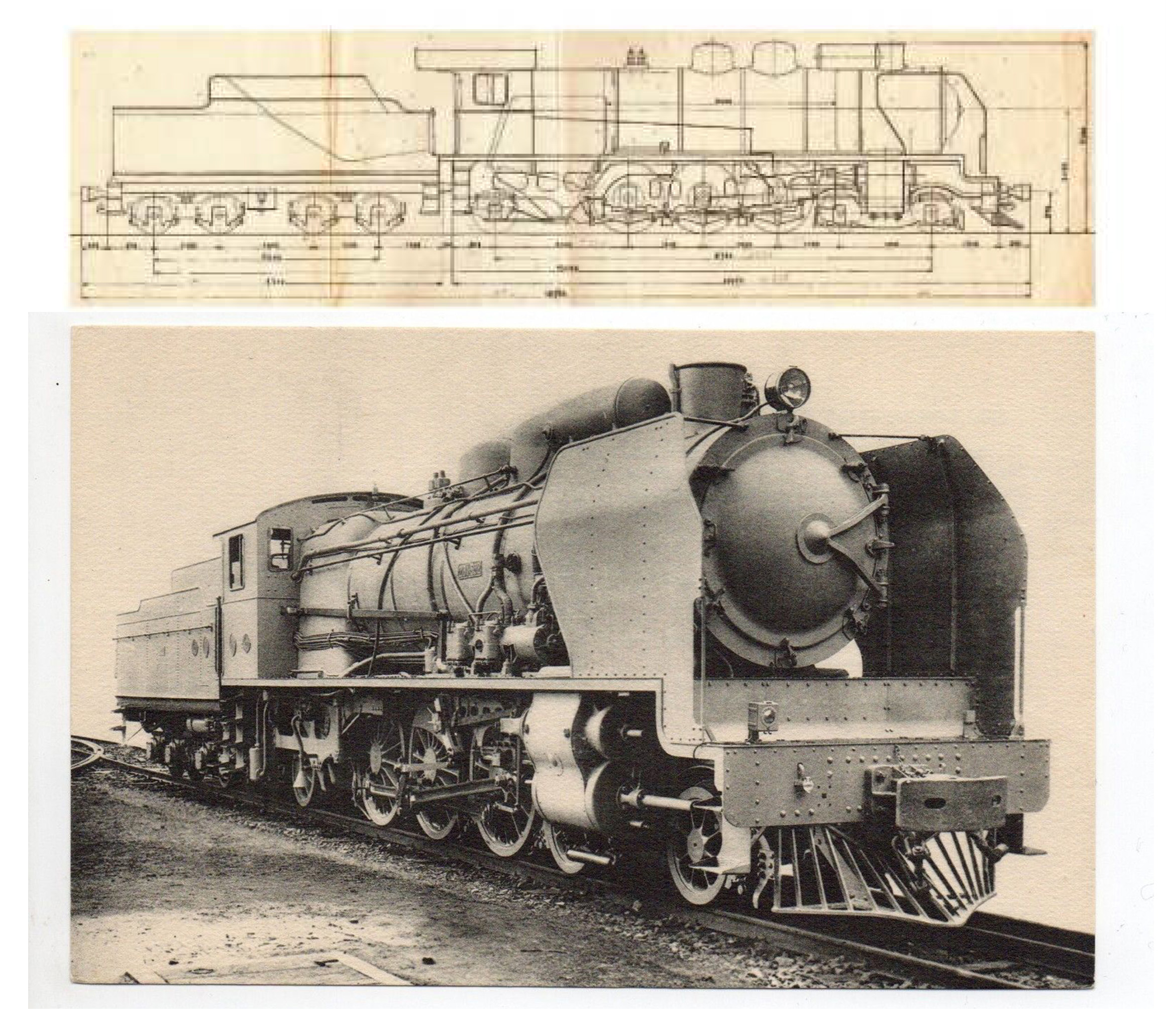
Schematic diagram and ex-works photo of SACM-Graffenstaden 4-6-2 “Pacific” No 231-502 (SACM No 7742, 1939), Collection Bernard Rozé
These locomotives, intended to circulate primarily on the last sections of the Transindochinois to be built, whose heavier equipment permitted a load increased to 13 tonnes per axle, constitute a reinforced version of their predecessors at 54,250 tonnes.
The maximum load was only reached on the three coupled axles, and, by adjusting the suspensions, it was possible to modify the distribution of the mass between coupled and load-bearing wheels and thus allow service on sections fitted with light rail, axle load then being reduced from 13 to 11 tonnes and the adherent weight from 39 to 33 tonnes.
The main advance was an increase from 1480mm to 1586mm in the diameter of the boiler, the length of which, however, remained unchanged. The “Super Pacific” thus had the same length of 4.60m between the tube sheets as their elders, so it could use the same tubes – in this case more numerous. With a stamp pressure of 14-16hpz, the power amounted to 1340hp. The tractive force of 9480kg allowed haulage of loads of up to 350 tonnes on inclines of 10‰ or 280 tonnes on inclines of 17‰.
Among other improvements, we should note the moulded steel cylinders lined with cast iron, the semi-automatic Henricot couplers⁹ and the smoke deflector screens, whose geometry gave these locomotives a typically French appearance.
The “Pacifics” and “Super Pacifics” both received the same type of bogie tender, which weighed 14.4 tonnes and allowed 16m³ of water and 6 tonnes of coal to be carried. The first series of 1933 was intended for an in-service speed limit of 80km/h, but the first locomotive No 1000 in the series reached 94km/h during tests. The “Super Pacifics” were designed to run at 100km/h, but they were limited to 90km/h in current service. However, this only applied to the brief period of peace experienced by the first units to be delivered, as their post-1945 cadets are unlikely to ever have reached such speeds on the battered wartime networks.
The “Mikados” of 1948
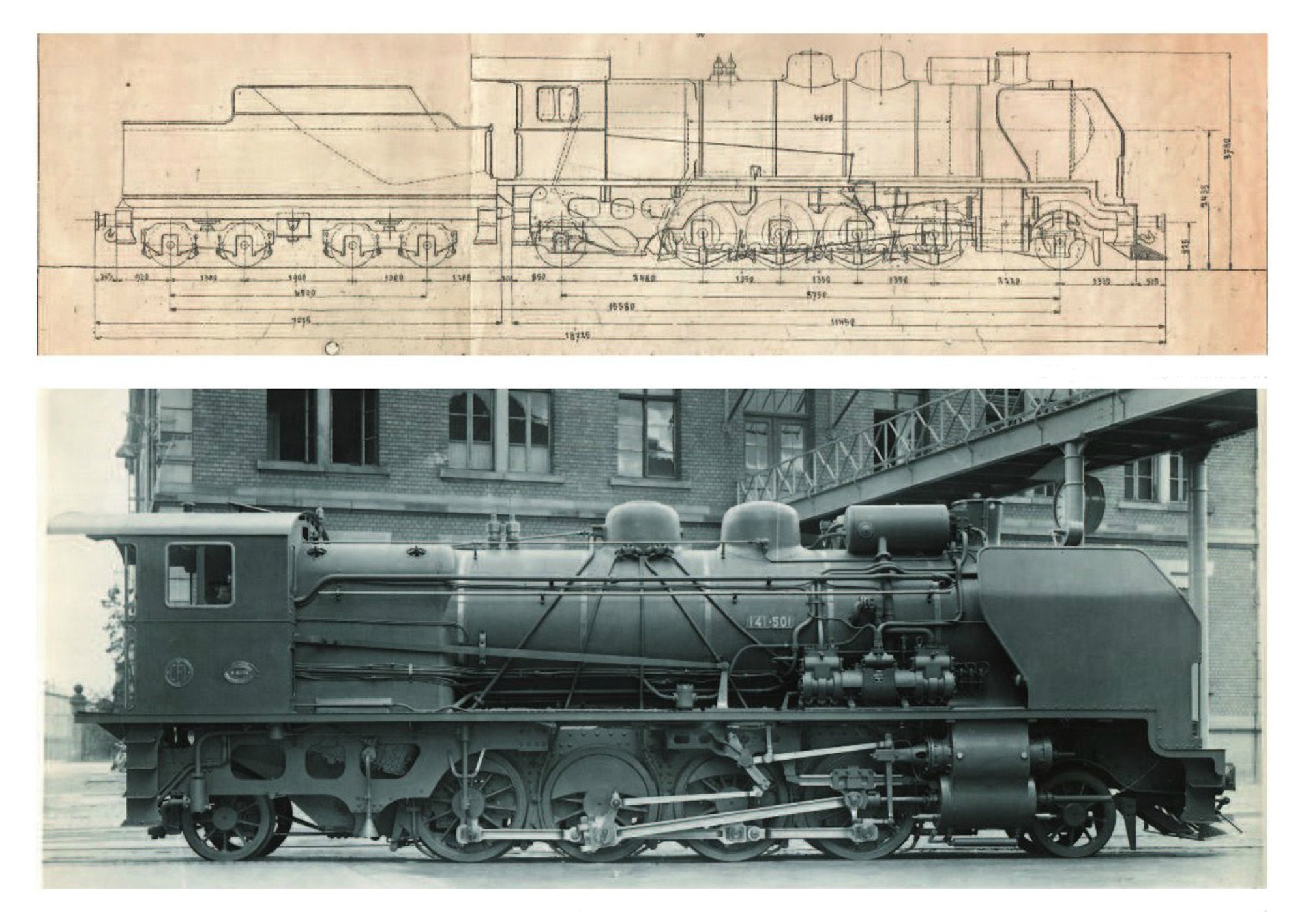
SACM-Graffenstaden 2-8-2 Mikado 141-500 schematic diagram, plus ex-works photo of 141-501, Collection Bernard Rozé
Appearing almost a decade after the “Super Pacifics,” the “Mikados” differed from them only by their wheel arrangement – and even the rear bogie was identical for the two types: the SNCF itself would never achieve such a degree of standardisation with its so-called “unified” locomotives!
With their four pairs of coupled wheels, the “Mikado,” however, presented an increased mass of nearly 3 tonnes. The reduction in the diameter of these coupled wheels from 1.40m to 1.20m brought the speed in service down to 60 km/h, but the tensile force was increased to 10,700kg. These locomotives were able to haul trains of 680 tonnes on a 10% incline or 400 tonnes on a 17% incline.
In addition, the brevity of the “Congolese episode” involving Nos 141-508 to 141-512 CFI suggests that the adaptation of this type of locomotive to the 1.067m track had been planned from their design, though no known text confirms this¹⁰.
The first “Mikado” received the same tenders as the “Pacifics” and “Super Pacifics,” but the following ones – the majority – carried “tank tenders” built by Baume-&-Marpent.
The North Vietnamese and Chinese “variations” of the SACM “Mikado” were distinguished from the basic type by their firebox made of steel rather than copper. In addition, they were instantly recognisable by their smoke deflector screens of larger dimensions, which had a very particular shape.
All these locomotives and tenders could subsequently be adapted to coal (North and South Việt Nam) or wood (South Việt Nam and Cambodia) firing.
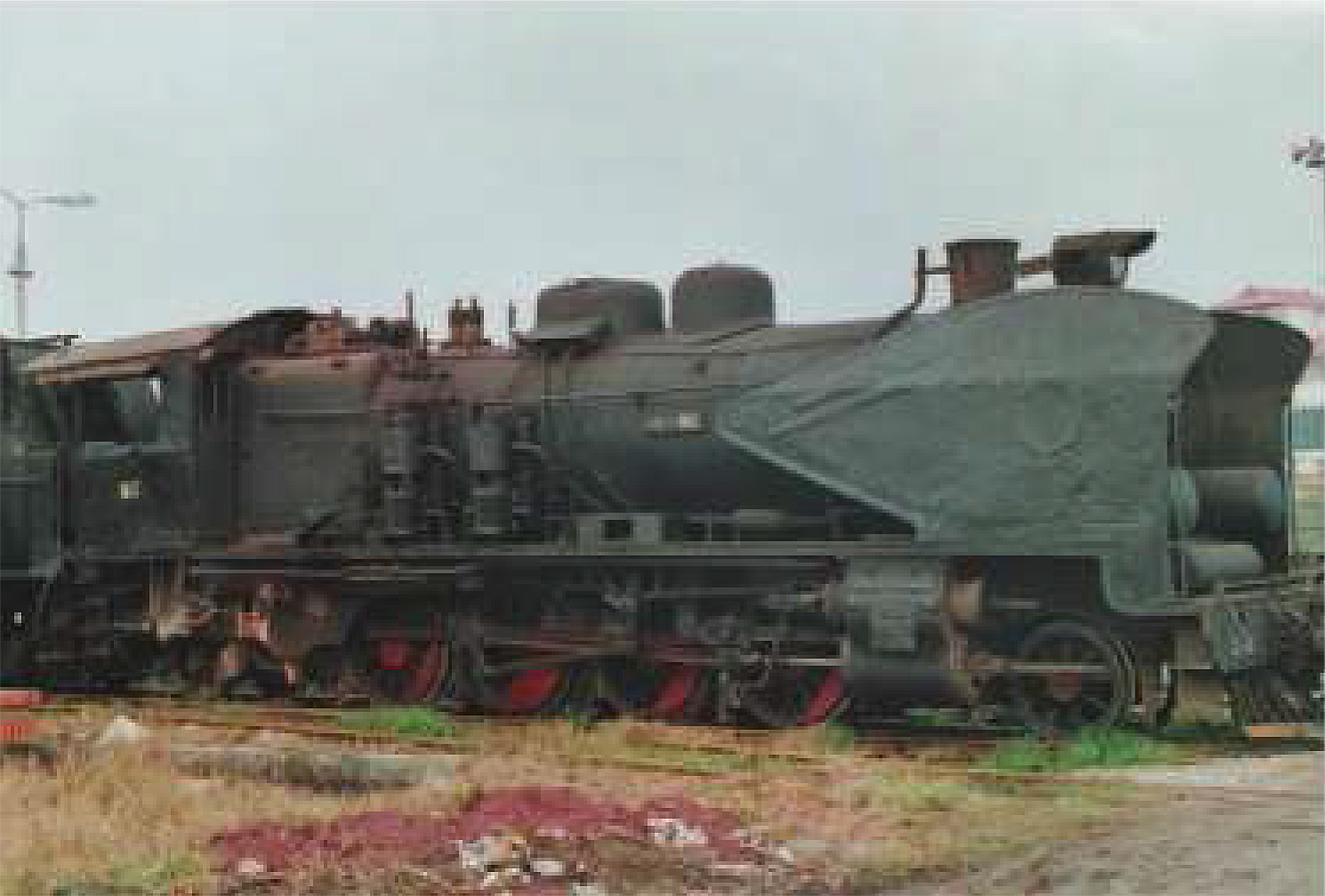
Pictured at Giáp Bát is No 141-165, a locomotive of Chinese construction whose profile nonetheless permits us to perceive the French influence. Photo Paul Carenco
Finally, in North Việt Nam:
– The Soulerin vacuum brake was replaced by the air brake, which explains the appearance, on all three types of machines, of fairly large air reservoirs between the screens and the smoke box;
– The old draw gear was replaced by automatic couplers.
Main sources:
Anonymous – Notice in Bulletin de la Societe Alsacienne, 1934
Frederic Hulot, Les Chemins de Fe de la France d’Outre-Mer: Indochine – Yunnan, Ed. La Regordane, 1990
Richard Pelham, Some Vietnam Puzzles, in Continental Railway Journey, 1992
David Gurnett, railwaysinvietnam.com website, 2013
Michael Pass, Cambodia Steam Today and Yesteryear, 2014
Acknowledgments: to Didier Delattre, Fabrice Lanoué, Yves Broncard, Luc Reynaud and Bernard Rozé
Footnotes
1. Obviously, these locomotives did not share anything other than this name with the famous 3-1200 of the Compagnie du Nord (231-C SNCF)
2. The total number of “Pacifics” delivered to Dakar (four), then to Abidjan (five), is corroborated by the allocation to the budget of French West Africa (AOF), at the beginning of 1949, of nine “Mikados” ordered for replace them in Indochina … but at least five of the “loaned” locomotives nevertheless made it to their destination, since 231-524 and 231-525 (ex-Dakar-Niger) and 231-529, 231-530 and 231-533 (ex-Abidjan-Niger) were present in Việt Nam in 1988 – restitutions having more than likely pre-dated independence.
3. These “Phnom-Penh Pacifics” (series CFSI Nos 1-7 then CFI 231-401 to 231-407), of German design and execution, have no other point in common with those which constitute the subject of this text other than their axle configuration.
4. The eight “Mikados” built specifically for the Congo-Océan were ceded to Mozambique in 1956; it is in this territory that the complete surveys have been carried out which today make it possible to confirm their “identity” (see table)
5. OFFERFROM: Office Central des Chemins de fer d’Outre-mer, Central Office of the French Overseas Railways; this organisation would become OFFERFOM after the independence of 1960 and would only intervene in the networks of French-speaking Africa and Madagascar
6. The original “identity” of this 141-551, which had quite intrigued us when we only knew of it through a photo of Guy Rannou, is today attested by its SACM number 8042.
7. The concordance between old and new numbers could not be established
8. At the end of the 1980s, discussing No 141-151 and its successors, an official letter from the ĐSVN Directorate, addressed to British tour operator Bill Alborough, did not hesitate to specify: “our Chinese friends faithfully copied the plans for the many locomotives they built for us.”
9. The Henricot coupling, which also fitted the passenger cars delivered to CFI at the same time, could be hidden by a removable buffer plate when the locomotive was attached to a train set comprising only conventional components. In fact, this equipment was not used widely on the non-conceded networks and it does not seem to have been planned for Nos 231-A-001 to 231-A-006 CFI.
10. In this hypothesis, the “universality” of the 203 SACM type would approach that of many more 141 USA-TCs known as MacArthur, which could be adapted to the track gauges of 1m (Cambodia, Tunisia, Franco-Ethiopian etc), 1.055 m (Algeria) and also 1.067m for, in particular, several British possessions.
11. We are unable to specify the construction stages to which each of the two types of tenders has been associated; in addition, exchanges also could be observed later in Việt Nam, where, for example, 231-534 was accompanied by a tank-tender during its last months of activity.
Pascal Béjui
Tim Doling is the author of The Railways and Tramways of Việt Nam (White Lotus Press, 2012) and the guidebooks Exploring Huế (Nhà Xuất Bản Thế Giới, Hà Nội, 2018), Exploring Saigon-Chợ Lớn (Nhà Xuất Bản Thế Giới, Hà Nội, 2019) and Exploring Quảng Nam (Nhà Xuất Bản Thế Giới, Hà Nội, 2020).
A full index of all Tim’s blog articles since November 2013 is now available here.

